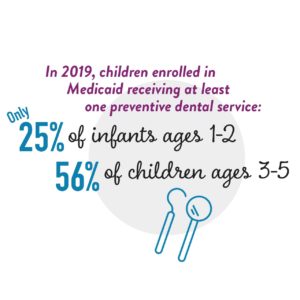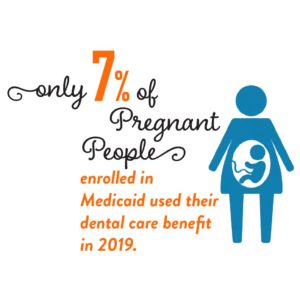Tooth decay is the leading chronic disease of childhood. Cavities are common, painful, and largely preventable. They remain the most common chronic disease of childhood – four times more common than asthma among adolescents aged 14 to 17 years, according to the CDC. The good news: Medicaid covers dental care for children enrolled in the program. The bad news: For many children on Medicaid, the dental care they need is simply not available – for a wide range of reasons.
 A new report and interactive data dashboard from NC Child dives into data on children & pregnant women enrolled in North Carolina’s Medicaid program, and whether they’re getting access to the oral health care they need. Until now, it has been difficult to track and evaluate the specific problems that North Carolinians face with respect to their oral health, due to lack of publicly available data. However, the NC Division of Health Benefits recently made comprehensive data available for the first time. These data cover people enrolled in Medicaid and NC Health Choice (CHIP) – representing about half of all children and pregnant people in the state.
A new report and interactive data dashboard from NC Child dives into data on children & pregnant women enrolled in North Carolina’s Medicaid program, and whether they’re getting access to the oral health care they need. Until now, it has been difficult to track and evaluate the specific problems that North Carolinians face with respect to their oral health, due to lack of publicly available data. However, the NC Division of Health Benefits recently made comprehensive data available for the first time. These data cover people enrolled in Medicaid and NC Health Choice (CHIP) – representing about half of all children and pregnant people in the state.
NC Child’s analysis of these new data found some striking indicators for the state’s oral health:
 Very few pregnant people enrolled in Medicaid are using the dental health benefit. This is troubling because a parent’s oral health during and after pregnancy can have significant impacts on young children’s health.
Very few pregnant people enrolled in Medicaid are using the dental health benefit. This is troubling because a parent’s oral health during and after pregnancy can have significant impacts on young children’s health.- Children in rural, eastern counties are much less likely to get the dental health care they need than children in other parts of the state. Check out the interactive data dashboard to see how children’s dental health care looks in your county.
- Among children enrolled in Medicaid, there are significant differences by race and ethnicity in who gets access to dental health care. Two-thirds of white children enrolled in Medicaid received at least one oral health service in 2019, compared to just over half of Black and American Indian children.
- The increasing rate of young children’s hospital emergency department visits for dental health problems signals a growing gap in preventive care.
 These data points underscore how many barriers are keeping children and families across the state from getting oral health care. In 2020, 98% of North Carolina counties faced a shortage of dental health professionals, according to the U.S. Department of Health and Human Services (DHHS). Children with special health care needs, who often need more specialized oral health care, face even greater struggles. COVID-19 has added new challenges. And in 2021, Medicaid transformation has made navigating the system even more confusing for families.
These data points underscore how many barriers are keeping children and families across the state from getting oral health care. In 2020, 98% of North Carolina counties faced a shortage of dental health professionals, according to the U.S. Department of Health and Human Services (DHHS). Children with special health care needs, who often need more specialized oral health care, face even greater struggles. COVID-19 has added new challenges. And in 2021, Medicaid transformation has made navigating the system even more confusing for families.
This report dives into the data and presents some solutions and policy recommendations. There is much that North Carolina’s leaders can do to ensure preventive care for children and pregnant individuals in the state’s Medicaid and NC Health Choice (CHIP) programs.
What does dental care look like in your county? Explore the data through the interactive data dashboard.


